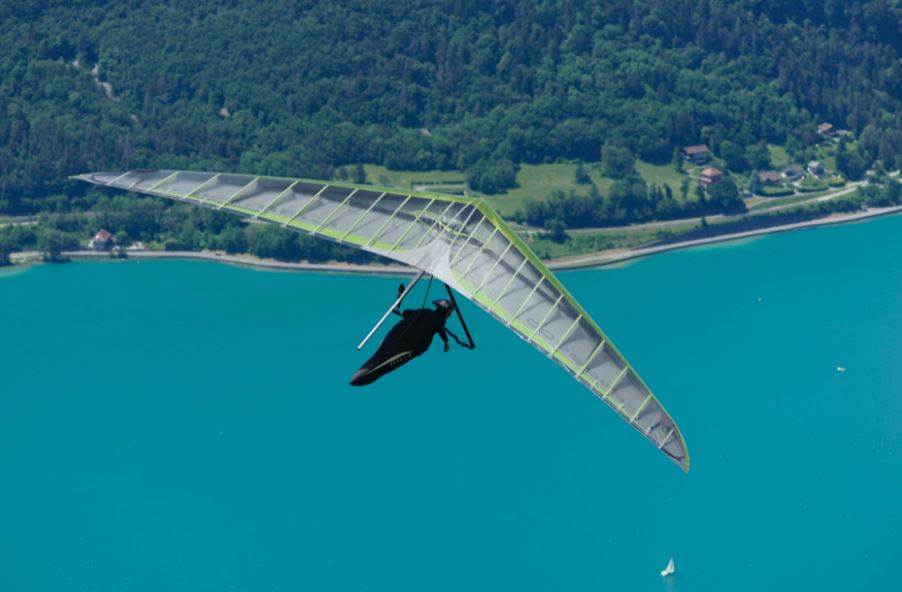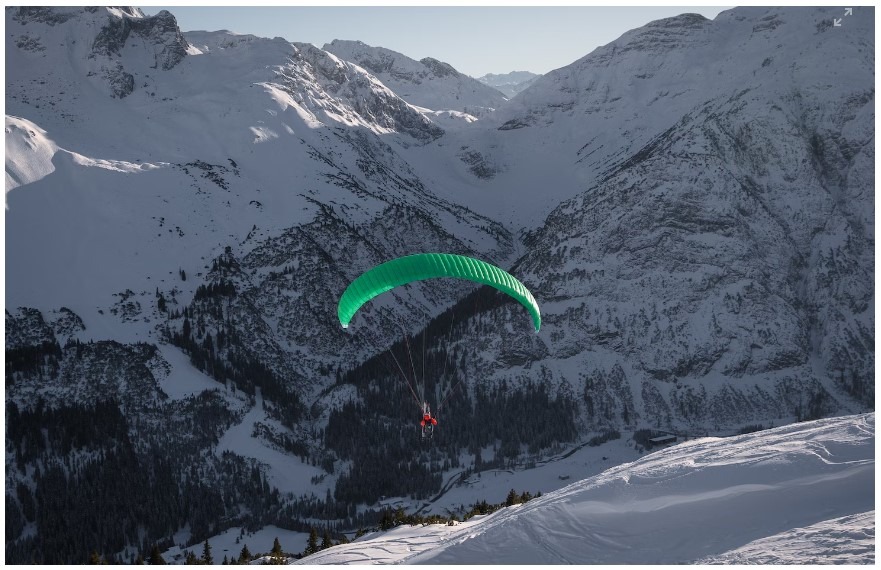Why Is Hang Gliding so Dangerous?

When you think about hang gliding, it's easy to picture the thrill of soaring through the sky like a bird. But have you ever considered why it's classified as one of the most dangerous sports? It's not just about strapping yourself to a wing and jumping off a cliff. The high incidence of pilot error, inadequate training, and unpredictable weather conditions all contribute to the risks. Even with advancements in safety gear, the sport demands precise control and quick decision-making, especially during critical phases like launching and landing. So, what makes these elements so perilous?
For one, pilot error remains a significant factor. Mistakes in judgment or technique can quickly lead to dangerous situations. Inadequate training exacerbates this issue, as newcomers might not be well-prepared for the complexities of the sport. Unpredictable weather conditions, such as sudden gusts of wind, can also pose serious threats that even experienced pilots might struggle to handle.
Despite advancements in safety equipment, hang gliding still requires a high level of skill and alertness. The most critical moments—launching and landing—demand precise control and rapid decision-making. A minor lapse in concentration can result in severe consequences.
Understanding these risks is crucial for anyone considering taking up hang gliding. Proper training, constant vigilance, and respect for the sport's inherent dangers are essential for minimizing risk.
Historical Background
Hang gliding's origins can be traced back to the 1960s, a period influenced by early aviation pioneers who inspired a new generation of airborne adventurers. Pioneers like Barry Hill Palmer and John Dickenson made significant contributions with their innovative designs. However, the sport's early stages were marked by a lack of formalized safety practices and comprehensive training, leading to numerous accidents.
In the 1960s, most hang gliders were homemade and lacked the advanced safety features of today's designs, contributing to a higher rate of accidents and fatalities. While Dickenson's control bar enhanced maneuverability, it did not eliminate the risks associated with the sport. Many early accidents were due to pilot error, primarily because pilots did not receive adequate training or have a sufficient understanding of flight dynamics.
The sport gained popularity after the 1976 IMAX film "To Fly!" highlighted its excitement but also reinforced its perceived dangers. Without structured training processes, new pilots often faced life-threatening situations. Over time, the hang gliding community recognized the need for better safety practices, but the early years were characterized by a steep learning curve and significant risks.
Mechanics of Hang Gliding
When hang gliding, you control the glider by shifting your body weight, which requires significant skill and precision. Proper launching and landing techniques are crucial, whether you are foot-launching from slopes or being towed by vehicles. Understanding these mechanics is vital, as most accidents are due to pilot error rather than equipment failure.
Control Bar Mechanics
Mastering the control bar is essential for any hang gliding enthusiast. The control bar is your primary interface with the glider, allowing you to control its pitch and roll by shifting your weight, which changes the center of gravity. This mechanism is crucial for maintaining stability and maneuverability, especially in diverse wind conditions.
To effectively use the control bar, focus on these three key aspects:
- Weight Shifts: Shifting your weight influences the glider's direction and altitude. Leaning forward or backward changes the pitch, while side-to-side movements control the roll.
- Grip and Maneuverability: Maintain a firm yet flexible grip on the control bar to allow for quick adjustments. The control bar, typically made from lightweight and durable materials, ensures responsiveness and ease of maneuverability.
- Training: Proper training is imperative. Understanding the mechanics of the control bar and practicing its use under various conditions will prepare you for real-world scenarios. Mismanagement, such as improper weight shifts or incorrect grips, can lead to severe consequences, including loss of control and potential crashes.
In hang gliding, mastering the control bar is not optional—it's your lifeline to safe and effective flight.
Launch and Landing Techniques
Mastering the mechanics of the control bar forms the core of hang gliding, but successfully launching and landing your glider is where theory meets practice. Launching requires a slope with a minimum gradient of 6:1, and pilots must always check wind conditions. Experienced pilots can manage winds up to 30 mph, but novices should stick to 0-18 mph for safety. Launching in appropriate conditions is essential to avoid early accidents.
Landing is even more critical. Your landing area should be at least 50x200 feet and free of obstructions. Managing your approach angle and speed during landing can make the difference between a smooth touchdown and a dangerous impact. Most accidents occur during this phase, so mastering landing techniques is crucial. Shifting your weight on the control bar to alter the center of gravity ensures a controlled descent.
Training programs emphasize practicing these techniques in various conditions to build proficiency and reduce the risk of accidents significantly. Proper preparation and understanding of these mechanics are vital to your safety in hang gliding. Effective launch and landing techniques can help keep you flying safely.
Common Accidents
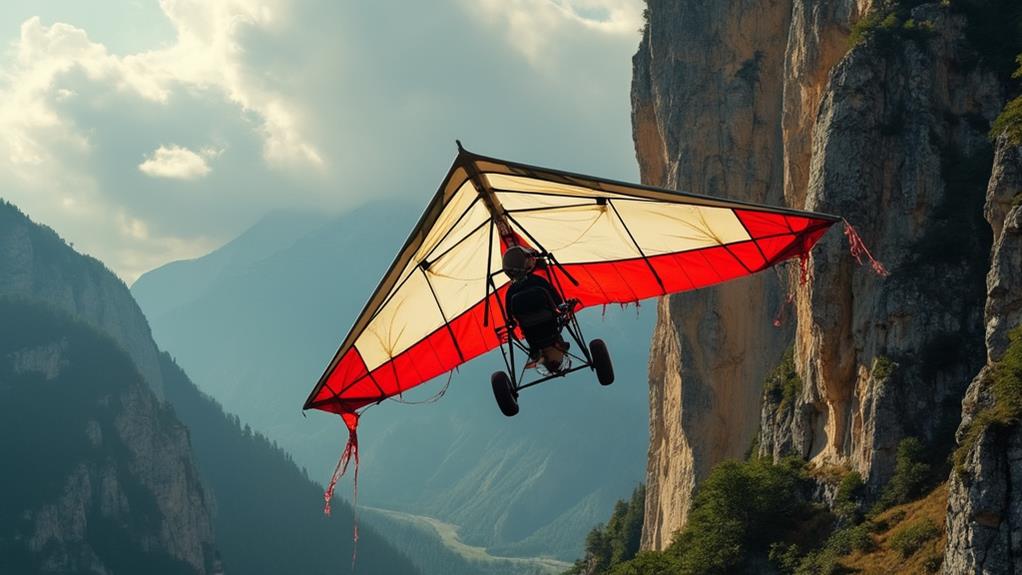
Why do so many hang gliding accidents occur? Over 90% of hang gliding accidents can be attributed to pilot error, highlighting the critical importance of skill and decision-making in flight safety. The fatality rate in hang gliding is about one per thousand participants annually, with recent years averaging three fatalities. Many incidents happen during the transition from training to solo flying, as new pilots often misjudge conditions, leading to accidents.
- Downtube breakage: This common issue is often underestimated by pilots, indicating a lack of awareness of safety risks.
- Transition phase: Many accidents occur when newly trained pilots make poor decisions, such as launching in unsuitable conditions.
- Accumulation of poor decisions: Misjudging wind conditions or failing to assess landing zones properly can lead to serious incidents, including crashes or fatalities.
The accumulation of poor decision-making can have severe consequences. Comprehensive training and increased awareness of common incidents are crucial for reducing the risk of accidents in hang gliding.
Pilot Decision-Making
Understanding the types of accidents that occur in hang gliding sets the stage for exploring the role of pilot decision-making in ensuring safety. As a pilot, you make around 50 vital decisions per hour during flight, demanding near-perfect judgment to avoid accidents. Your risk perception is crucial; data indicates that intermediate pilots, rather than beginners, are more susceptible to incidents. This underscores the importance of continuously evaluating risks and learning.
When you push beyond your personal limits, especially due to overconfidence, you set yourself up for potentially dangerous situations. Many accidents occur when pilots attempt to launch in suboptimal conditions, driven by the desire to fly despite the risks. Effective decision-making means recognizing when conditions are too risky and having the discipline to ground yourself if necessary.
Safety in hang gliding isn't just about skills; it's about making the right calls, particularly as weather conditions change. For newly graduated pilots, underestimating these challenges can be fatal. Remember, the average fatality rate in hang gliding is one per thousand participants annually. Stay vigilant, respect your limits, and prioritize safety to enjoy a safer flight experience.
Training and Ratings
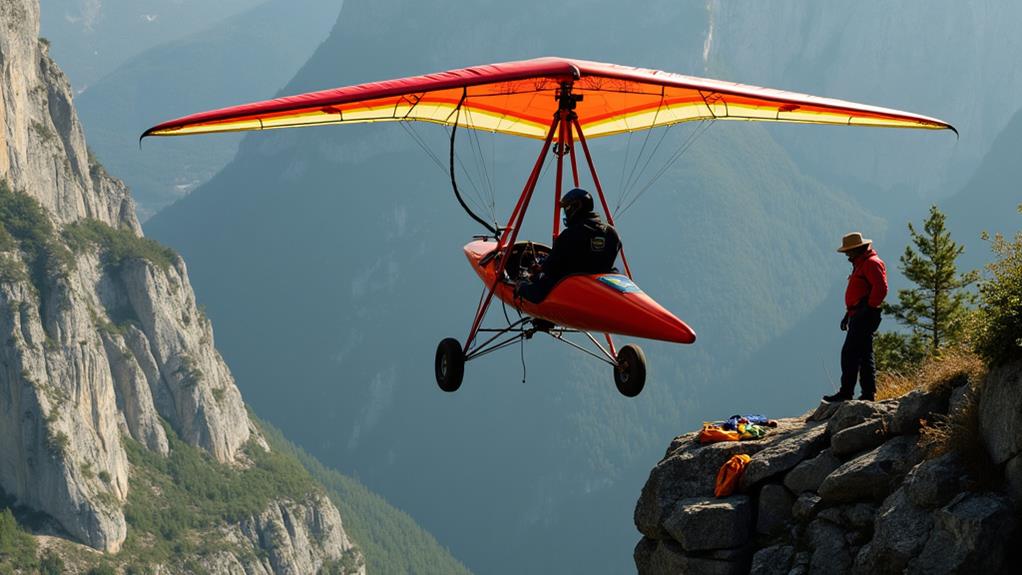
Mastering hang gliding requires thorough training and a robust rating system to ensure safety. Typically, you'll need 5-10 lessons with certified instructors to achieve initial proficiency ratings, ensuring you possess essential skills before flying solo. The United States Hang Gliding and Paragliding Association (USHPA) has a rating system from H1 (beginner) to H5 (master) that standardizes skill progression and safety protocols among pilots.
Training encompasses both practical flying skills and theoretical knowledge, which are crucial for minimizing risk. You'll learn about:
- Meteorology - Understanding weather patterns to make informed flying decisions.
- Equipment Inspection - Ensuring your gear is in optimal condition.
- Emergency Procedures - Preparing for and managing unexpected situations.
Despite thorough training, most hang gliding fatalities occur post-training when pilots fly independently. This underscores the importance of ongoing education and strict adherence to safety practices, even after obtaining proficiency ratings. As you transition to more advanced flying conditions, the risks increase. Therefore, continuous learning and refining your decision-making skills are essential.
Equipment Failures
Equipment failures in aerial activities can quickly transform an exhilarating experience into a dangerous situation. Common issues like downtube breakages, particularly during landings, and parachute deployment failures can have severe consequences. To mitigate these risks and ensure safety, regular maintenance and thorough inspections are indispensable.
Downtube Breakage Rates
Downtube breakage is a common issue in hang gliding, frequently occurring during landings and almost normalized within the pilot community. These incidents can significantly increase the accident rate, underscoring the need for more durable equipment. Smaller pilots often experience bone fractures before the downtube breaks, indicating a mismatch between pilot size and equipment strength.
The high rate of downtube breakage suggests that many pilots may underestimate the risks associated with weaker components in their gliders. Recognizing patterns in downtube failures is crucial for enhancing safety practices. Let's consider the implications:
- Equipment Durability: Downtubes must be robust enough to withstand the stresses of landings and potential mishaps.
- Maintenance Costs: With an average replacement cost of around $65, frequent breakages lead to increased maintenance expenses.
- Safety Practices: Identifying and addressing the root causes of downtube breakage can inform better landing techniques and equipment design.
Parachute Deployment Failures
Parachute deployment failures highlight critical issues related to emergency preparedness in hang gliding. These failures often result from improper packing or malfunctioning equipment, severely compromising safety during emergencies. Notably, over 90% of such incidents stem from pilot error rather than equipment failure, emphasizing the importance of pilot experience and adherence to maintenance protocols.
Regular inspections and maintenance of your parachute system are essential. Neglecting these tasks increases the risk of the parachute failing to open or function correctly during an emergency descent. High-speed descents or entanglement with the glider can complicate parachute deployment, underscoring the need for comprehensive training in emergency procedures.
Statistical data indicates that while hang gliding has a relatively low fatality rate, parachute deployment issues significantly contribute to serious accidents. Effective safety measures and thorough pilot education are crucial for mitigating these risks. By prioritizing regular inspections, proper packing, and rigorous training, you can enhance your emergency preparedness and reduce the likelihood of catastrophic outcomes.
Weather Conditions

Weather conditions are crucial for the safety of hang gliding, as turbulent weather can transform an exhilarating flight into a hazardous experience. Wind gusts exceeding 30 mph can make launching and landing extremely challenging, often resulting in a loss of control. Sudden weather changes, such as unexpected storms or wind shifts, create dangerous flying conditions that are hard to predict and manage.
Thermal activity, consisting of rising columns of warm air, can be particularly tricky. These thermals can cause abrupt altitude changes, making it difficult to maintain stable flight. Strong thermal activity often leads to turbulence, which can destabilize the glider.
For inexperienced pilots, navigating these conditions can be especially daunting. Here are three key points to consider:
- Wind Gusts: Gusts over 30 mph can compromise control during launch and landing.
- Turbulence: Strong thermal activity can lead to turbulence, destabilizing your glider.
- Weather Awareness: Being unaware of local weather patterns greatly increases the risk of accidents.
Always stay informed about weather conditions to avoid hazardous flying situations. Flying in poor visibility or challenging weather can quickly turn your hang gliding adventure into a dangerous encounter.
Risk Management
Risk management in hang gliding is crucial for ensuring both safety and enjoyment. Your decision-making significantly influences the risks you encounter while airborne. On average, you'll make about 50 critical decisions per hour of flight, each impacting your safety. Notably, over 90% of hang gliding accidents result from pilot error, emphasizing the importance of sound judgment and adherence to safety protocols.
Transitioning to more challenging flying conditions carries increased risks, making ongoing learning and self-assessment essential even after initial training. Regularly evaluate your skills and knowledge before facing new challenges. Thorough equipment inspections are another vital aspect of risk management; neglecting maintenance can lead to equipment failure and higher accident risk.
Hang gliding fatalities average around one per thousand participants annually. While this figure may appear low, it underscores the importance of effective risk management strategies to minimize accidents. By making informed decisions, following safety protocols, continuously learning, and inspecting your equipment, you can significantly reduce your risks and enjoy a safer hang gliding experience.
Safety Improvements
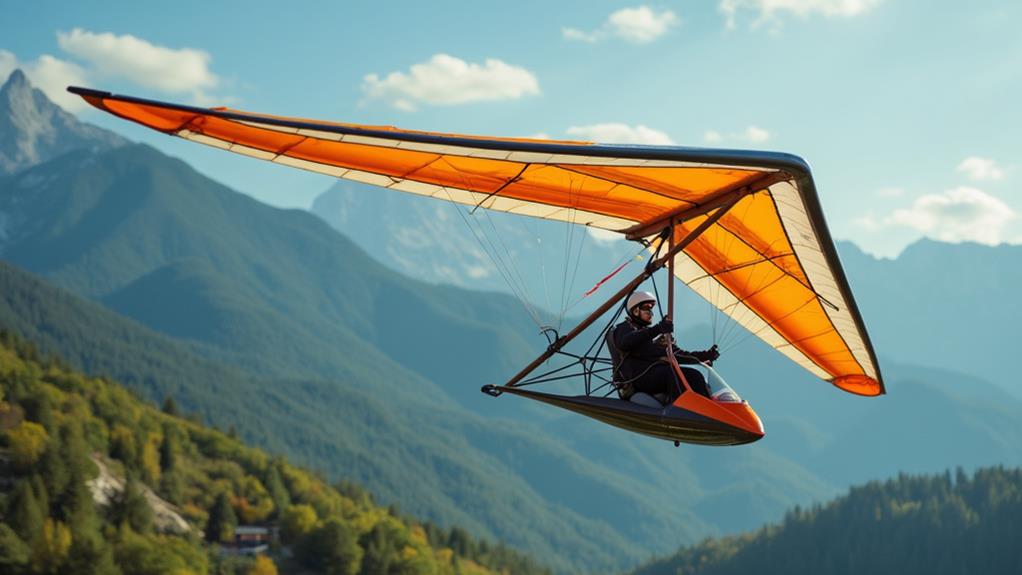
Advancements in safety gear and training have dramatically improved hang gliding safety over the years. Modern parachutes, helmets, and radios have played a crucial role in reducing fatality rates from an average of 31 per year (1974-1979) to about 7 per year recently. Here's how safety has improved:
- Safety Gear: Enhanced parachutes, helmets, and communication devices significantly increase your chances of survival in the event of mid-air issues.
- Proficiency Ratings: The US Hang Gliding and Paragliding Association (USHPA) has introduced proficiency ratings, ensuring that pilots progress through skill levels safely, thereby reducing risks associated with pilot error.
- Equipment Maintenance: Regular inspections and maintenance of hang gliding equipment are essential. Proper upkeep can prevent accidents caused by equipment failure.
Additionally, standardized training programs have greatly decreased accidents, with over 90% attributed to pilot error rather than equipment problems. Continuous education and awareness about decision-making and risk management also play a crucial role. By refining your judgment skills, you can make better decisions, improving your safety. Embracing these advancements can make your hang gliding experience safer and more enjoyable.
Community and Culture
Within the close-knit hang gliding community, the bonds formed through shared experiences and risks are exceptionally strong. Pilots often develop deep emotional connections, particularly when faced with injuries or fatalities in the sport. This awareness of danger cultivates a culture focused on safety and mutual support.
Safety practices are a frequent topic of discussion within the community. Pilots share personal stories and experiences to educate one another, enhancing collective knowledge on effective risk management. This practice not only builds camaraderie but also helps to ensure everyone's well-being as they pursue their shared passion for flying.
Efforts to increase diversity within the hang gliding community are also noteworthy. Initiatives aim to attract younger participants and underrepresented groups, broadening the sport's appeal and ensuring its continued growth. Despite the inherent risks, the strong sense of camaraderie and shared enthusiasm for hang gliding create a resilient culture.

